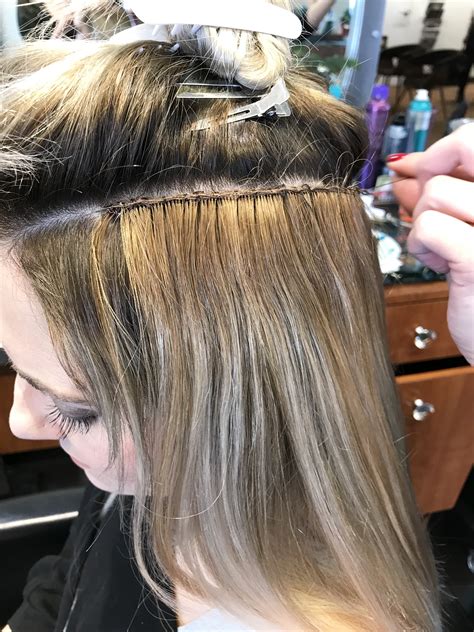Exploring the Symphony of Natural Hair and Extensions
Hair holds immense cultural significance, reflecting personal style, heritage, and self-expression. Blending natural hair with extensions can elevate one’s appearance and tap into the boundless potential of hair transformations.

Understanding the Market of Hair Extensions: A Global Panorama
The global hair extensions market is flourishing, predicted to surpass $10 billion by 2026 (MarketWatch, 2022). This growth is attributed to rising consumer demand for versatile and customizable hair solutions.
Types of Hair Extensions: Navigating the Tapestry of Options
- Clip-In Extensions: Temporary, easy-to-install wefts that can be effortlessly added and removed.
- Tape-In Extensions: Bonds to natural hair using thin tape adhesives, providing a semi-permanent attachment.
- Fusion or Bonded Extensions: Strands of hair are fused to natural hair using keratin or glue, offering a long-lasting result.
- Micro-Link Extensions: Hair strands are attached to small beads, ensuring a discreet and seamless transition.
Choosing the Right Extension Type: A Journey of Personalization
- Consider hair texture: Match the texture of your extensions to your natural hair to ensure a harmonious blend.
- Decide on hair length: Determine the desired length and volume of your extensions to achieve the look you envision.
- Factor in hair thickness: Choose extensions with a density that complements your natural hair to prevent bulky or thin results.
Blending Techniques: The Art of Seamless Integration
- Sectioning: Divide hair into small sections to work with smaller areas at a time.
- Layering: Place extensions in staggered layers to create a natural and dimensional effect.
- Blending: Use styling tools and products to refine the transition between natural hair and extensions.
Caring for Your Extensions: A Commitment to Longevity
- Wash and condition regularly: Cleanse extensions gently and use products specifically designed for extension care.
- Avoid heat damage: Limit the use of heat styling tools and protect extensions from sun exposure.
- Regular maintenance: Visit a professional stylist for regular trims and adjustments to preserve their condition.
Benefits of Hair Extensions: Embracing the Transformative Power
- Enhanced volume and length: Extensions instantly add volume and length to create fuller and more voluminous hair.
- Versatile styling options: Experiment with different hairstyles and colors, expanding your styling possibilities.
- Confidence booster: The transformative power of hair extensions can elevate self-confidence and enhance self-esteem.
- Corrective solutions: Extensions can effectively conceal hair loss, damage, or thinning areas, providing a restorative option.
Addressing Pain Points: Understanding Consumer Concerns
- Cost: Hair extensions can be expensive, especially for high-quality and long-lasting options.
- Damage: Improper installation or maintenance can potentially damage natural hair.
- Styling limitations: Some hairstyles may not be suitable for extensions, limiting styling versatility.
Motivations for Seeking Hair Extensions: A Deeper Understanding
- Special occasions: Enhance your appearance for weddings, proms, or other special events.
- Hair growth: Extensions can be used to accelerate the appearance of hair growth while waiting for natural hair to reach desired length.
- Style experimentation: Explore new hairstyles, textures, and colors without committing to permanent changes.
- Confidence enhancement: Extensions can boost self-confidence by providing a solution to perceived hair flaws.
FAQs: Addressing Common Queries
- Can extensions damage my natural hair? Yes, improper installation or maintenance practices can lead to damage.
- How long do extensions last? The longevity of extensions varies depending on the type, maintenance routine, and lifestyle.
- Can I wash and style my extensions? Yes, but use products and techniques specifically designed for extensions to avoid damage.
- Do extensions require professional installation? While some types can be self-installed, professional installation is recommended for long-lasting results.
- Can I sleep with extensions in? Yes, but use a satin sleep cap to prevent tangling and breakage.
- What are the signs of hair damage from extensions? Breakage, thinning, or excessive shedding indicate potential damage.
New Applications: Sparking Innovation in Hair Extension Utilization
- Hair extensions for male pattern baldness: Concealing thinning areas or creating the appearance of fuller hair.
- Extensions for hair loss due to cancer treatments: Providing a non-surgical and aesthetically pleasing solution.
- Extensions for protective styles: Braiding or locking extensions can protect natural hair from breakage.
- Extensions for hair volume optimization: Enhancing hair quantity without sacrificing length.
Tables for Quick Information: Providing Organized Insights
Table 1: Types of Hair Extensions and Their Features
| Extension Type | Method of Attachment | Durability | Cost |
|---|---|---|---|
| Clip-In | Clips | Temporary (removable) | Low |
| Tape-In | Adhesive tape | Semi-permanent | Moderate |
| Fusion or Bonded | Keratin or glue | Long-lasting | High |
| Micro-Link | Small beads | Discreet and seamless | Moderate |
Table 2: Benefits and Drawbacks of Hair Extensions
| Benefit | Drawback |
|---|---|
| Enhanced volume and length | Cost |
| Versatile styling options | Potential for damage |
| Confidence booster | Styling limitations |
| Corrective solutions | Maintenance required |
Table 3: Considerations for Choosing Hair Extensions
| Factor | Considerations |
|---|---|
| Hair texture | Match the texture of your extensions to your natural hair. |
| Hair length | Determine the desired length and volume of your extensions. |
| Hair thickness | Choose extensions with a density that complements your natural hair. |
Table 4: Hair Extension Care Tips
| Care Practice | Purpose |
|---|---|
| Wash and condition regularly | Cleanse extensions and maintain their health. |
| Avoid heat damage | Protect extensions from heat styling tools and sun exposure. |
| Regular maintenance | Visit a professional stylist for trims and adjustments. |
